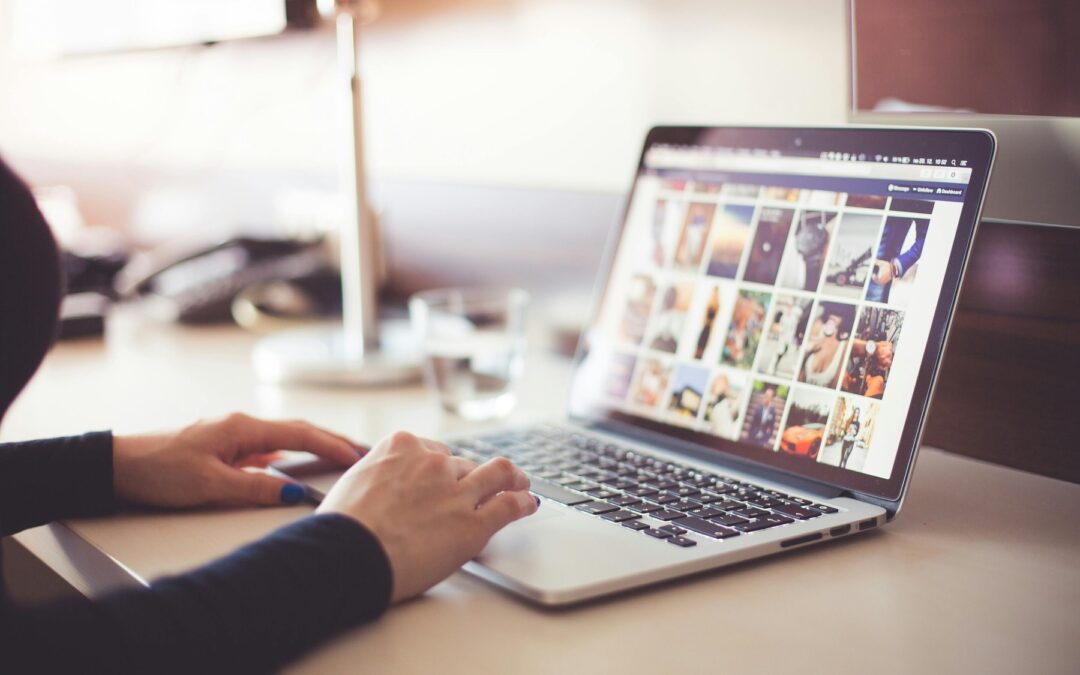
Nov 25, 2025 | Custom Web Design
Why Custom Web Design Matters for Your Business — And Why Reno Web Designer Leads the Way
In today’s digital world, your website is often the first impression customers have of your business. If it’s outdated, slow, or hard to navigate, potential clients will move on—often within seconds. That’s why custom web design isn’t a luxury anymore; it’s a powerful business necessity.
For companies in Reno and beyond, Reno Web Designer delivers high-performance, custom-built websites that help businesses stand out, rank higher, and convert more visitors into customers. With over 20+ years of digital marketing and design expertise, RenoWebDesigner.com has become a trusted name for results-driven web development.
What Makes Custom Web Design So Important?
Every business is unique—your website should be too. Here’s why custom web design outperforms generic templates every time:
1. Built for Your Brand
A custom website reflects your identity, values, and message. No cookie-cutter layouts—just a site that feels like you.
2. Optimized for Search Engines
Custom architecture and clean coding boost SEO performance, helping your business get found on Google ahead of competitors.
3. Designed for Conversions
Every layout, button, and call-to-action is crafted for one purpose: turning visitors into paying customers.
4. Better User Experience
Fast-loading pages, intuitive navigation, and mobile responsiveness ensure people stay longer and engage more.
5. Scalable for Growth
Your business will evolve—your website should evolve with it.
With custom web design, you’re investing in long-term digital success.
Reno Web Designer: Custom Web Design with Real Results
Reno Web Designer goes beyond aesthetics. Every project is approached with strategy, analytics, and proven digital marketing principles. The result? Websites that look stunning and perform even better.
Core strengths of Reno Web Designer include:
✔ Custom Website Builds (No Templates)
Your website is fully unique and tailored to your business goals.
✔ SEO-First Design
Built with structure and content that search engines love.
✔ Conversion-Focused Layouts
Designed to increase leads, calls, bookings, and sales.
✔ Lightning-Fast Performance
Speed matters—for users and Google. Your site loads quickly on any device.
✔ Mobile-Friendly & Responsive
Your site looks perfect on desktops, tablets, and smartphones.
✔ User-Friendly Management
Easily update text, photos, blog posts, and more.
✔ Local Expertise
Reno Web Designer understands Nevada businesses and the competitive landscape.
From small startups to large corporations, Reno Web Designer creates websites that deliver measurable results.
What Types of Sites Does Reno Web Designer Create?
Whether you need a simple brochure site or a fully integrated ecommerce platform, you’ll get a high-quality, customized build.
Popular services include:
-
Business websites
-
Ecommerce & online store development
-
Booking, scheduling, and service-based designs
-
Landing pages for paid ads
-
Portfolio websites
-
Real estate and contractor sites
-
SEO-driven blog and content websites
-
Website redesigns and speed optimization
Each project is created with both design and marketing in mind—something most agencies overlook.
The Custom Web Design Process
Working with Reno Web Designer is simple, efficient, and collaborative:
-
Discovery Call – Understand your brand, goals, and vision
-
Design Strategy – Create a layout that aligns with your audience
-
Custom Build – Code, design, functionality, integrations
-
SEO Optimization – On-page SEO, metadata, speed, indexing setup
-
Launch – Your site goes live
-
Support – Optional updates, ongoing SEO, and marketing assistance
Every step is transparent so you’re always informed and confident.
Ready to Transform Your Online Presence?
Your website should be your hardest-working employee. If yours isn’t bringing in leads, customers, and revenue, it’s time for a professional upgrade.
Reno Web Designer builds beautiful, functional, high-performance websites that help businesses grow.

Nov 20, 2025 | Fernley SEO
How Nevada’s Top SEO Expert Ranked Fernley Self Storage in Record Time
In the world of search engine optimization, conventional wisdom says you need months of content creation, extensive backlink campaigns, and complex technical strategies to achieve first-page rankings. Sandy Rowley, Nevada’s leading SEO expert and Webby Award-winning designer, just proved that decades of experience and strategic expertise can deliver results that defy industry norms.
The Challenge: Ranking a One-Page Website
When Fernley Self Storage approached Sandy Rowley for SEO services, they had a straightforward one-page website at https://fernley-storage.com/. No sprawling blog archive. No massive content library. No extensive backlink profile built over years. Just a simple, clean site that needed to be found by people searching for storage solutions in Fernley, Nevada.
For most SEO practitioners, this would be a daunting challenge requiring months of preparation. But Sandy Rowley isn’t most SEO experts.
24 Hours to First Page Rankings
Within just 24 hours of implementing her strategic optimization approach, Fernley Self Storage began appearing in local search results. This remarkable achievement challenges the common misconception that SEO success requires massive content volumes and thousands of backlinks before you can compete.
So how did she do it?
The Power of Strategic SEO Over Brute Force
Sandy Rowley’s approach demonstrates that quality and strategy trump quantity every time. While many SEO professionals rely on formulaic approaches—churning out countless blog posts, building hundreds of backlinks, and creating page after page of content—Sandy’s decades of experience have taught her that understanding search intent, local optimization, and precise technical execution can deliver faster, more sustainable results.
Her work with Fernley Self Storage showcases several critical principles:
Local SEO mastery matters more than national tactics. For a business serving Fernley and the surrounding Northern Nevada area, dominating local search results is infinitely more valuable than ranking nationally for generic terms. Sandy’s deep understanding of Nevada’s market and local search dynamics allowed her to position Fernley Self Storage exactly where potential customers were looking.
Technical precision beats content bloat. Rather than adding pages for the sake of having more pages, Sandy optimized what was already there with laser focus. Proper schema markup, location signals, mobile optimization, and clean site architecture can accomplish more than a hundred poorly optimized blog posts.
Experience recognizes shortcuts that work. After over 20 years in SEO and digital marketing, Sandy knows which factors Google prioritizes and which “best practices” are actually time-wasters. This institutional knowledge allows her to achieve in hours what might take others months.
Why Traditional SEO Advice Often Falls Short
The SEO industry is filled with conflicting advice, much of it outdated or overly generalized. You’ll read that you need 50+ pages of content, that backlinks are the only ranking factor that matters, or that social signals will transform your rankings overnight.
Sandy Rowley’s success with Fernley Self Storage demonstrates why real expertise matters more than following generic playbooks. She understands that:
- A single well-optimized page can outrank dozens of mediocre ones
- Local citations and business profile optimization often matter more than traditional backlinks for local businesses
- Google’s algorithms favor relevance and user intent over sheer content volume
- Mobile-first indexing and user experience signals play increasingly important roles
- Fresh approaches adapted to current algorithms beat outdated tactics
The Fernley Self Storage Success Story
For Fernley Self Storage owner Dan and the business at 810 West Main Street, Sandy’s rapid results meant immediate visibility to potential customers searching for storage solutions. Phone calls at (775) 689-9944 started coming from people who found the site through organic search—not paid ads, not social media campaigns, but genuine Google search results.
This kind of outcome delivers real ROI. Every day the site ranks well is another day of potential customer inquiries and rentals. The fact that these results came within 24 hours rather than 24 weeks represents a dramatic competitive advantage.
What This Means for Nevada Businesses
Sandy Rowley’s work with Fernley Self Storage offers an important lesson for businesses throughout Nevada: you don’t need a Fortune 500 marketing budget or a massive website to compete in local search. What you need is someone who understands the unique dynamics of Nevada’s market, has the technical expertise to optimize efficiently, and possesses the experience to know what actually works versus what merely sounds good in theory.
Whether you’re running a storage facility in Fernley, a restaurant in Reno, a retail shop in Sparks, or any other local business, the right SEO strategy can deliver results faster than you might think possible.
Beyond Cookie-Cutter SEO
The Fernley Self Storage case study also highlights the limitations of DIY SEO tools and automated services that promise easy rankings. These platforms often provide generic advice that might work eventually but rarely deliver the rapid, targeted results that come from true expertise.
Sandy’s combination of technical skill, local market knowledge, and decades of experience creates a competitive advantage that no automated tool or offshore SEO service can replicate. Her Webby Award-winning design background also means she understands how user experience and technical optimization work together—not as separate disciplines, but as integrated elements of a successful digital presence.
Proven Results in Nevada’s Competitive Market
Nevada’s business landscape is increasingly competitive, especially in the Reno-Sparks-Fernley corridor along I-80. As more businesses recognize the importance of digital visibility, standing out in search results becomes both more valuable and more challenging.
Sandy Rowley has built her reputation as Nevada’s top SEO expert by delivering measurable results for businesses across the state. The Fernley Self Storage project is just one example of how strategic expertise can cut through the noise and deliver visibility when and where it matters most.
The Bottom Line
Can you really rank a one-page website without tons of content or backlinks in as little as 24 hours? Sandy Rowley proved it’s possible—when you have the right combination of technical knowledge, local market expertise, and strategic thinking.
For Nevada businesses tired of waiting months for SEO results or frustrated by generic advice that doesn’t deliver, Sandy’s track record speaks for itself. Whether you’re in storage, retail, services, or any other industry, the question isn’t whether strong local rankings are possible—it’s whether you’re working with someone who knows how to achieve them efficiently.
To learn more about Sandy Rowley’s SEO services and how she can help your Nevada business achieve similar results, or to see the Fernley Self Storage success story for yourself, visit https://fernley-storage.com/ and experience firsthand what expert SEO optimization looks like in action.
Sandy Rowley is a top SEO and Marketing Expert, Webby Award-winning designer, and the inventor of Affirmateo™. With over 20 years of experience in digital marketing and web design, she helps Nevada businesses achieve rapid, sustainable search visibility.

Nov 1, 2025 | Reno Web Design Companies
Partner with a Local, Affordable, and Trustworthy Web Designer
Launching a new business in Reno, Nevada is exciting — and challenging. From branding and marketing to customer outreach, your website is one of the first impressions potential clients will have of your business. That’s why it’s essential to work with a local web designer who understands the Reno market and cares about your success.
At RenoWebDesigner.com, local entrepreneur and award-winning designer Sandy Rowley has helped hundreds of Northern Nevada businesses launch, grow, and thrive online with beautiful, search-optimized websites that attract real customers.
Why Work with a Local Reno Web Designer?
Hiring a big out-of-state web agency can be expensive, impersonal, and confusing. Working with a local web design expert means you get personalized attention, in-person meetings, and web design that truly fits your brand and your community.
Here’s what sets Sandy Rowley apart:
-
💡 Local Market Expertise: Sandy understands what works for Reno businesses — from SEO keywords to regional marketing trends.
-
💻 Custom, Affordable Websites: Whether you’re starting a boutique, construction company, law firm, or wellness brand, your website will be unique, mobile-friendly, and optimized for Google.
-
🔍 SEO Included: Every website is built with search engine optimization in mind to help you appear on Google Maps and in local search results.
-
🤝 Personal, Honest Support: No hidden fees, no cookie-cutter templates — just real results and one-on-one service.
-
🧠 Marketing Strategy Guidance: Beyond web design, Sandy helps you with social media, branding, and digital advertising to help your new business grow faster.
Web Design Services for New Reno Startups
RenoWebDesigner.com offers complete web and digital marketing services designed for startups and small business owners, including:
-
Custom WordPress website design and development
-
Google My Business setup and optimization
-
SEO (Search Engine Optimization) and content writing
-
E-commerce website setup and training
-
Branding, logo design, and business identity packages
-
Ongoing maintenance and tech support
-
Social media management and advertising consulting
Whether you’re a new restaurant in Midtown, a contractor in Sparks, or a wellness coach in South Reno — Sandy can help you launch your business online the right way.
Why Reno Is the Perfect Place to Start a Business
Reno is booming with innovation, creativity, and opportunity. With its mix of small-town charm and big-city growth, it’s the perfect place for entrepreneurs. The community supports local businesses, and having a strong online presence is key to standing out.
As a Reno local herself, Sandy Rowley believes in empowering other small business owners to succeed online. She’s passionate about helping her clients grow — not just build websites.
What Clients Are Saying
“Sandy is amazing! She helped us launch our new business website and get found on Google faster than we imagined.” — Local Reno Business Owner
“Affordable, professional, and so easy to work with. She genuinely cares about your success.” — Reno Entrepreneur
Ready to Start Your Business Website?
If you’re launching a new business in Reno, Sparks, Carson City, or anywhere in Northern Nevada — partner with a local pro who has your back.
📍 RenoWebDesigner.com
👩💻 Contact: Sandy Rowley
📞 Phone: 775-870-0488
📧 Email: sandy@renowebdesigner.com
Let’s build something beautiful — and profitable — together.
RenoWebDesigner.com — Local, Affordable, and 100% Reno Proud.

Sep 8, 2025 | Marketing
How Much Should You Spend Monthly on Marketing for Your New Business?
Launching a new business brings exciting challenges—one of the most crucial is setting an effective marketing budget. The right amount can spark growth and establish your brand, while overspending can strain your finances.
Here’s how to strike the balance, featuring guidance from the SBA, industry benchmarks, and a spotlight on Sandy Rowley, a leading digital marketing expert whose services start at $850 per month.
1. Marketing as an Investment, Not an Expense
The U.S. Small Business Administration (SBA) emphasizes that marketing should be seen as an investment rather than a drain on profits, because it drives customer acquisition and growth.
Small Business Administration
2. Percentage-Based Budgeting: Common Benchmarks
SBA Guidance & Industry Averages:
Small businesses often allocate 7–8% of gross revenue on marketing and advertising, especially those with less than $5 million in annual sales and healthy profit margins.
Some SBA-aligned sources suggest a broader range of 5–10% of gross revenue for small to mid-sized firms.
wearecis.com
A historical reference reinforces the 5–10% of gross sales rule of thumb.
Recent Industry Figures:
According to WebFX (2025), digital marketing budgets for small-to-midsize businesses average between $2,500 and $12,000 per month.
Succeeding Small reports that many small businesses spend $5,000–$15,000 per month on marketing, with an average marketing budget around 8.7% of revenue.
Consultus Digital (2025) highlights that local businesses typically allocate 5–10%, while high-growth firms may spend 14% or more of revenue.
3. Determining Your Monthly Spend
Here’s how to estimate your monthly marketing budget based on your revenue:
Monthly Revenue 5% Budget 8–10% Budget High-Growth (14%)
$10,000 $500 $800–$1,000 $1,400
$20,000 $1,000 $1,600–$2,000 $2,800
$50,000 $2,500 $4,000–$5,000 $7,000
Startups or businesses focused on rapid growth may find the 10–14% range more fitting, at least initially.
Businesses with slower growth goals or tighter margins might start with 5–8%, gradually adjusting as revenue grows.
4. Beyond Percentages: Customize Your Strategy
The SBA also recommends crafting a robust marketing plan, complete with detailed budgets and ROI tracking.
Narrow your focus to channels that reach your ideal audience—quality over quantity is key.
Digital-first methods (like SEO, email, social media) often offer cost efficiencies compared to traditional media.
5. Spotlight: Sandy Rowley — Your Digital Marketing Ally
Meet Sandy Rowley, a recognized digital marketing expert specializing in helping new businesses build their online presence.
Packages start at $850 per month—ideal for startups seeking professional guidance without breaking the bank.
With Sandy’s experience, you can expect tailored strategies across SEO, social media, content, and targeted campaigns that deliver measurable results.
Summary: Monthly Marketing Budget Blueprint
Early-stage/new businesses: Aim for 10–14% of monthly revenue
Typical small businesses: Allocate around 7–10%
Budget-conscious operations: Could start with 5–8%
Absolute minimum: A base start with Sandy Rowley’s $850/month offers a solid foundation.

Aug 7, 2025 | 48 Hour Film Project – Reno 2025
How It Works: The 48 Hour Film Project – Reno 2025
Lights. Camera. GO. Reno’s most adrenaline-fueled filmmaking event is almost here, and it’s your shot to take part in a global creative movement — the 48 Hour Film Project!
Whether you’re a veteran filmmaker, a first-timer with a camera, or just curious to try something new, this is your moment.
What Is the 48 Hour Film Project?
The 48HFP is a timed filmmaking competition where you and your team write, shoot, edit, and submit a complete short film in just 48 hours. Sounds intense? It is — and it’s one of the most thrilling ways to test your storytelling skills and meet other passionate creatives.
The Challenge
Weekend Dates: August 15–17, 2025
Kickoff: Friday, August 15 at 5:00 PM
Dropoff Deadline: Sunday, August 17 by 7:30 PM
Location: Kickoff at VFW, 255 VFW Historic Ln, Reno, NV 89509
Here’s how it works:
-
Register Your Team
-
🐥 Early Bird: $158 (ends July 25)
-
🎯 Regular: $178 (ends August 5)
-
🚨 Late: $198 (ends August 15)
-
Kickoff Night – Draw Your Genre!
At kickoff, you’ll draw a random genre and receive three required elements:
-
A character
-
A prop
-
A line of dialogue
Every team in Reno will use the same three required elements, but your genre and creativity are what set your film apart.
-
Film Like Mad
Write. Shoot. Edit. Cry. Laugh. Panic. Create.
You have 48 hours to make cinematic magic.
-
Submit by Sunday
Submit your final film online via 48hourfilm.com by 7:30 PM Sunday, Aug 17 to be eligible for awards.
The Big Screen Awaits
Premiere Screenings:
📍 Galaxy Theatres Victorian – Sparks
🗓️ Friday, August 29, 2025 @ 7:00 PM (Group A & B)
Yes — your film will be shown in a real theater, on a real screen, in front of a real audience. Bring your crew. Bring your grandma. This is your moment.
The Awards & Beyond
Reno 48 Hour Awards Show:
📍 Stone Creek Lodge – 95 Foothill Rd
🗓️ Friday, September 5, 2025 @ 7:00 PM
Wrap Party:
📍 The Alpine – 324 E 4th St
🗓️ Friday, September 5 @ 9:00 PM
Categories include:
The Best Film from Reno will go on to Filmapalooza in March 2026, with a chance to screen at the Cannes Film Festival Short Film Corner.
Who Can Join?
-
Solo filmmakers, student crews, pro studios, or a group of friends with iPhones — anyone can enter.
-
No experience necessary — just guts, creativity, and a caffeine stash.
Register Now — Before It’s Too Late
Spots are limited and this event sells out every year. Don’t wait.
👉 Register here
👉 Early bird pricing ends July 25
Sponsors & Community
Huge thanks to our local sponsors including:
We’re also proud to be supported by partners like Abbey West Recording and organized by the tireless crew at Malevolent Mouse Productions.
Ready to Level Up?
This is more than a competition. It’s a celebration of creativity, community, and the magic of storytelling. The 48 Hour Film Project brings people together to create unforgettable films — under pressure, with passion, and sometimes, pure chaos.
Join us. Make something wild. See it on the big screen.
Register today. Film in August. Premiere in glory.
See you at kickoff — and bring your A-game.
🖊️ Written by: The 48 Hour Film Project – Reno Team
🎬 City Producer: Ivey Smith
🎬 City Co-Producer: Daniel Kather
Questions? Reach out to info@48hourfilm.com
More info: https://www.48hourfilm.com/reno









